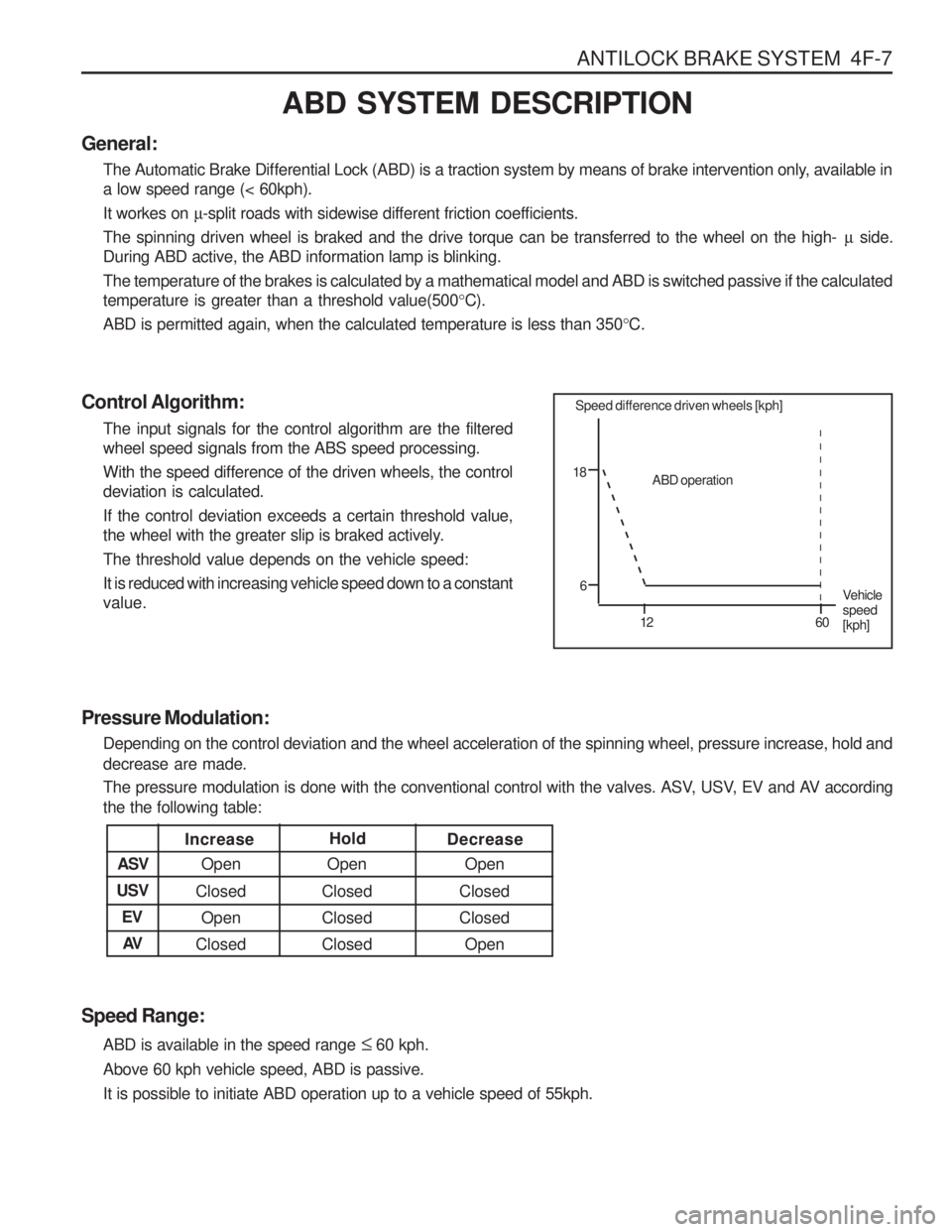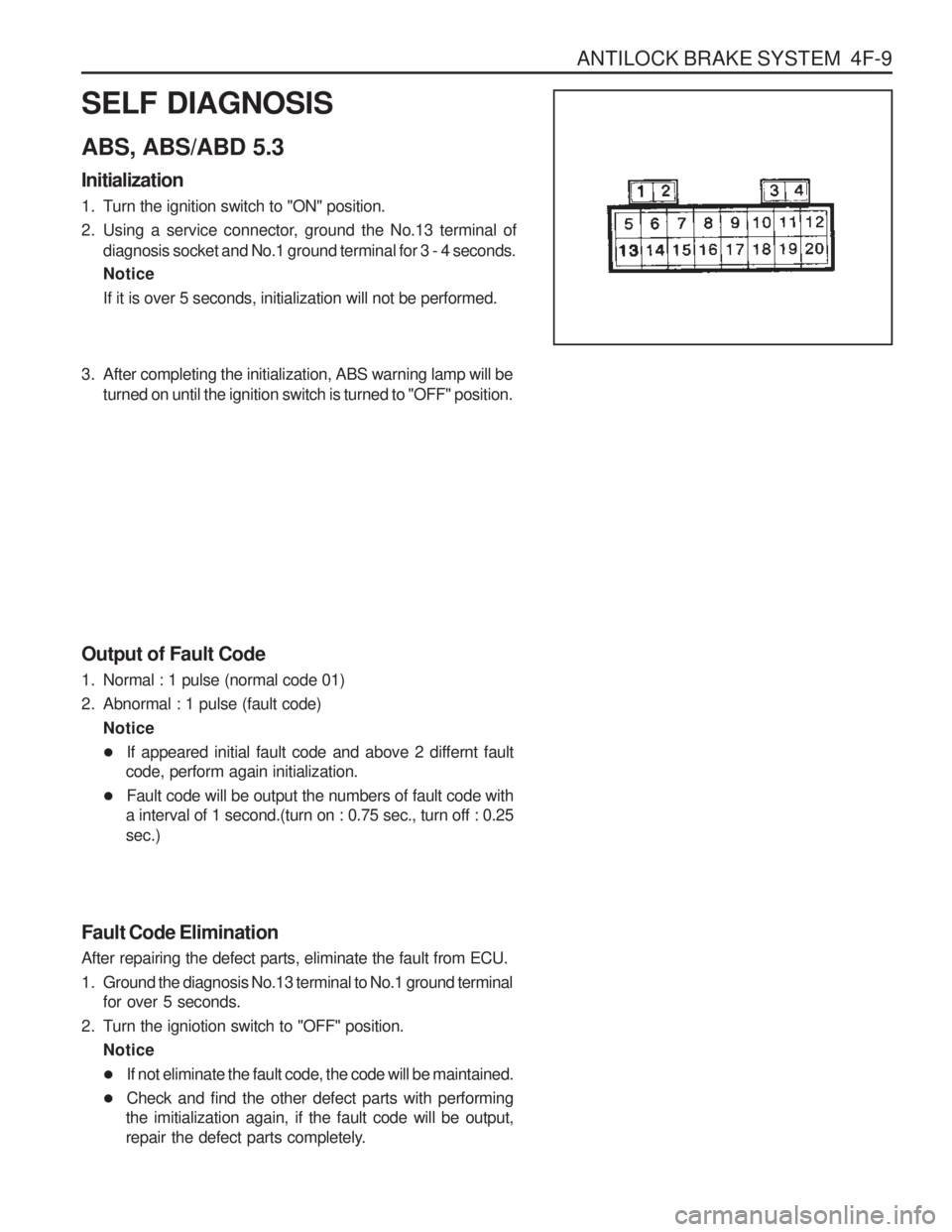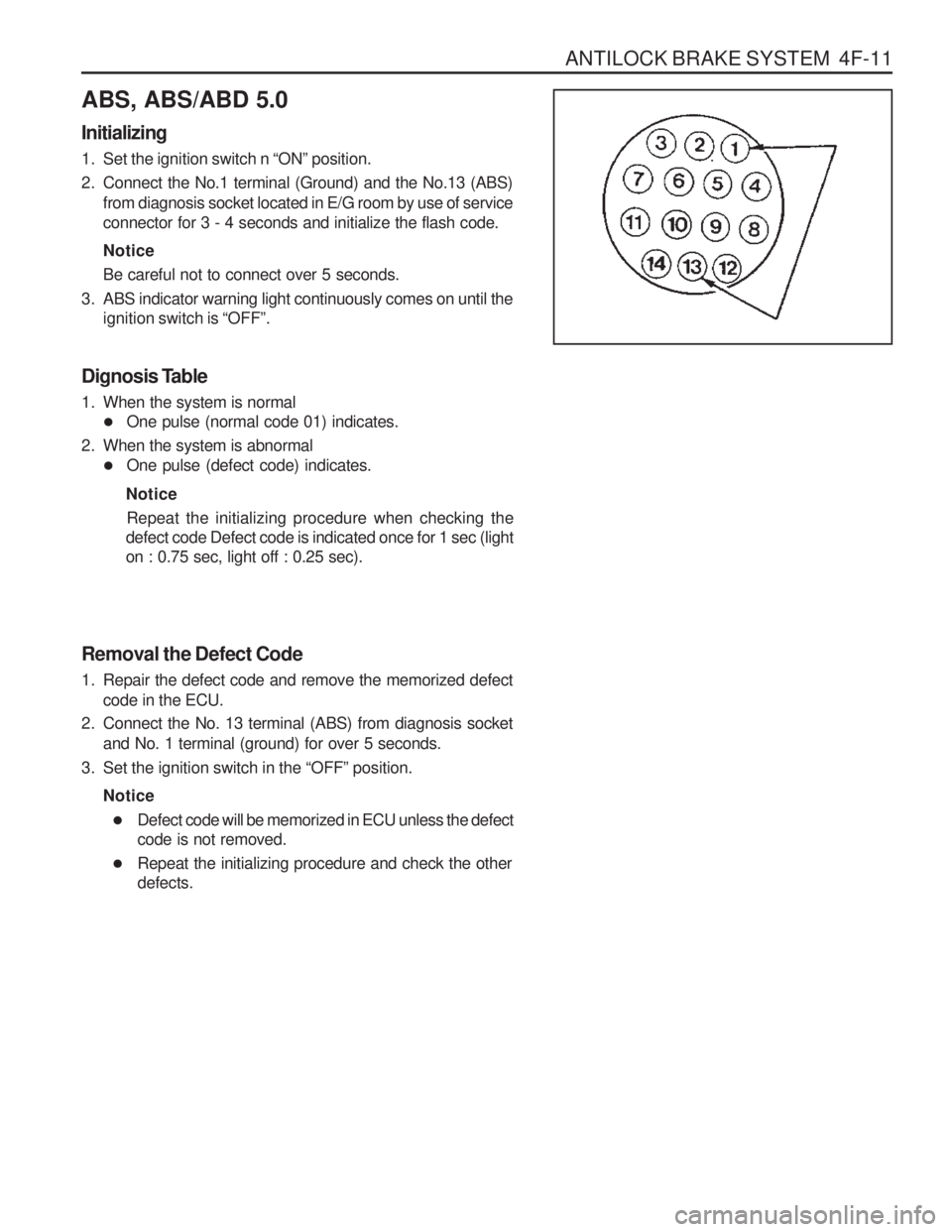Page 834 of 1574
ANTILOCK BRAKE SYSTEM 4F-5
ABS/ABD 5.3
5.0W5.0W
Page 835 of 1574
4F-6 ANTILOCK BRAKE SYSTEM
ABS,ABS/ABD
COMPONENT LOCATOR
1 ABS Hydraulic Unit
2 ABS/ABD Hydraulic Unit
3 Diagnosis Socket
4 Front Wheel Speed Sensor
5 Front Impulse Ring 6 Rear Wheel Speed Sensor
7 Rear Impulse Ring
8 ABS Warning Indicator Light
9 TCS Indicator Light
1 0 ABS/ABD ECU
Page 836 of 1574

ANTILOCK BRAKE SYSTEM 4F-7
ABD SYSTEM DESCRIPTION
General: The Automatic Brake Differential Lock (ABD) is a traction system by means of brake intervention only, available in a low speed range (< 60kph). It workes on µ-split roads with sidewise different friction coefficients.
The spinning driven wheel is braked and the drive torque can be transferred to the wheel on the high- µ side.
During ABD active, the ABD information lamp is blinking.The temperature of the brakes is calculated by a mathematical model and ABD is switched passive if the calculated temperature is greater than a threshold value(500 °C).
ABD is permitted again, when the calculated temperature is less than 350 °C.
Control Algorithm: The input signals for the control algorithm are the filteredwheel speed signals from the ABS speed processing. With the speed difference of the driven wheels, the control deviation is calculated. If the control deviation exceeds a certain threshold value,
the wheel with the greater slip is braked actively. The threshold value depends on the vehicle speed:It is reduced with increasing vehicle speed down to a constant value.
Pressure Modulation: Depending on the control deviation and the wheel acceleration of the spinning wheel, pressure increase, hold and decrease are made.
The pressure modulation is done with the conventional control with the valves. ASV, USV, EV and AV according the the following table:
Speed Range: ABD is available in the speed range � 60 kph.
Above 60 kph vehicle speed, ABD is passive. It is possible to initiate ABD operation up to a vehicle speed of 55kph.
Increase Open
Open
Open
ASV Decrease
Hold
Closed
Closed
Closed
Closed
Closed
Open
Open
Closed
Closed
USV
EVAV
Speed difference driven wheels [kph]
18
6 12 60ABD operation
Vehicle speed[kph]
Page 837 of 1574

4F-8 ANTILOCK BRAKE SYSTEM
Temperature Model:ABD operation is a high thermal load for the brakes.
To avoid any damages at the brakes, the disk temperature is calculated with a mathematical model for each driven
wheel separately. After ignition on, the calculation starts with 30 °C and then three different phases are evaluated
separately and added: ABD operation, braking and coling phase.If the temperature is highter than 500 °C, ABD is disabled for this wheel.
It is permitted again, if the model has calculated down the 350 °C.
Lamp Concepts: The system is equipped with an ABD information lamp, which is blinking during ABD operation.The activation of the EBD, ABS warning lamp and the ABD info lampo is summarized in the following table:
IgnitionON ABS
Operation ABD
Operation System failure
(EBD,ABS or ABD are
not distinguished) ABD passive due
to temperature
model
ABS warning lamp
ABD info lamp
EBD warning lamp 2s on for lamp
check
2s on for lamp check
2s on for lamp check OFF
EBD operation / OFFOFF
OFF
Dlinking
(Flashing)
OFF ON
OFF ON OFF OFF OFF
Page 838 of 1574

ANTILOCK BRAKE SYSTEM 4F-9
SELF DIAGNOSIS ABS, ABS/ABD 5.3 Initialization
1. Turn the ignition switch to "ON" position.
2. Using a service connector, ground the No.13 terminal ofdiagnosis socket and No.1 ground terminal for 3 - 4 seconds. Notice If it is over 5 seconds, initialization will not be performed.
3. After completing the initialization, ABS warning lamp will beturned on until the ignition switch is turned to "OFF" position.
Output of Fault Code
1. Normal : 1 pulse (normal code 01)
2. Abnormal : 1 pulse (fault code) Notice
� If appeared initial fault code and above 2 differnt fault
code, perform again initialization.
� Fault code will be output the numbers of fault code with
a interval of 1 second.(turn on : 0.75 sec., turn off : 0.25 sec.)
Fault Code Elimination After repairing the defect parts, eliminate the fault from ECU.
1. Ground the diagnosis No.13 terminal to No.1 ground terminal for over 5 seconds.
2. Turn the igniotion switch to "OFF" position. Notice
� If not eliminate the fault code, the code will be maintained.
� Check and find the other defect parts with performing
the imitialization again, if the fault code will be output,
repair the defect parts completely.
Page 840 of 1574

ANTILOCK BRAKE SYSTEM 4F-11
ABS, ABS/ABD 5.0 Initializing
1. Set the ignition switch n “ON ” position.
2. Connect the No.1 terminal (Ground) and the No.13 (ABS) from diagnosis socket located in E/G room by use of service connector for 3 - 4 seconds and initialize the flash code. Notice Be careful not to connect over 5 seconds.
3. ABS indicator warning light continuously comes on until the ignition switch is “OFF ”.
Dignosis Table
1. When the system is normal � One pulse (normal code 01) indicates.
2. When the system is abnormal � One pulse (defect code) indicates.
Notice Repeat the initializing procedure when checking the
defect code Defect code is indicated once for 1 sec (light on : 0.75 sec, light off : 0.25 sec).
Removal the Defect Code
1. Repair the defect code and remove the memorized defect code in the ECU.
2. Connect the No. 13 terminal (ABS) from diagnosis socket and No. 1 terminal (ground) for over 5 seconds.
3. Set the ignition switch in the “OFF ” position.
Notice � Defect code will be memorized in ECU unless the defect code is not removed.
� Repeat the initializing procedure and check the otherdefects.
Page 846 of 1574

ANTILOCK BRAKE SYSTEM 4F-17
Application
Power Voltage
Residual Temperature Measurement (ABD only) Acceleration Sensor Signal (wire)Defect Code
28 29 42Description
when switch knob (planger) is pressed by 3mm : �
- Each ends resistance value of the switch when switch knob(plunger) is not pressed : less than 200 m �
� When brake is applied :
ECU (ABS:No.14, ABD:No.48) terminal 11 - 14 V
or VBattery.When brake is released : ECU (ABS:No.14, ABD:No.48) terminal 0 V
� Check battery voltage.
� Resistance between ECU (ABD:No.28 & 29,
ABS:No.19) pins and battery negative terminal :
less than 20 m �
� Resistance between ECU No.1 (ABS:NO.15) pin and
ignition terminal : less than 60 m �
� Check that normal voltage is applied to ECU
(ABD:No.1, ABS:No.15) pin when ignition switch is turned to "ON" or "OFF".
� Check ABS fuses of 15A and 80A.
� Replace the ECU.
� Check wire (ECU No.50) for open or loose contact.
� Check connection between connectors.
� Check relevant wires for open or short.(When connector is removed)
� Check voltage between ECU side ground (ABD:No.1,
ABS:No.15 pin) and acceleration sensor side ground(ABD:No.1, ABS:No.15 pin / ECU side ABD:No.39, ABS:No.30 pin)
(When connector is installed and power is applied)
- Voltage : less than 0.25 V
� Check voltage among related terminals.(When connector is installed and power is applied)
- Voltage between ECU (ABD:No.43, ABS:No.28 pin
and ABD:No.39, ABS:No.30 pin) : 4.75 - 5.25 V
- Signal voltage between ECU (ABD:No.51, ABS:No.10) pin and (ABD:No.39, ABS:No.30) pin : 1.95 V - 3.45 V
(Measure it by laying acceleration sensor horizon- tally and without external force)
Page 847 of 1574
4F-18 ANTILOCK BRAKE SYSTEMApplication
Defect Code Description
� Check connection between connectors.
� Check relevant wires for open or short. (When connector is removed)
� Check and replace the acceleration sensor.
� Replace the ECU.
� Check voltage between ECU side ground (ABD:No.1,ABS:No.15 pin) and acceleration sensor side ground(ABD:No.1, ABS:No.15 pin / ECU side ABD:No.39,ABS:No.30 pin) (When connector is installed and power is applied)
- Voltage : less than 0.25 V
� Check voltage among related terminals.(When connector is installed and power is applied)
- Voltage between ECU (ABD:No.51, ABS:No.10
pin and ABD:No39, ABS:No.30) pin: 4.75 - 5.25 V
- Signal voltage between ECU (ABD:No.51, ABS:No.10 pin and ABD:No39, ABS:No.30) pin: 1.95 V - 3.45 V (Measure it by laying acceleration sensor horizon tally and without external force)
43
Acceleration Sensor Signal (Signal)